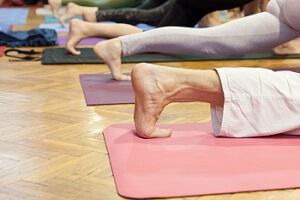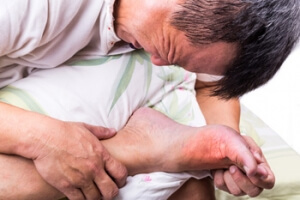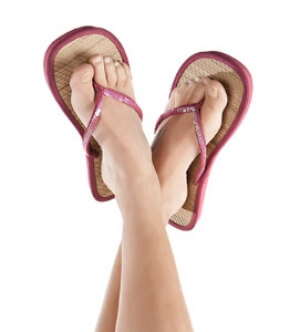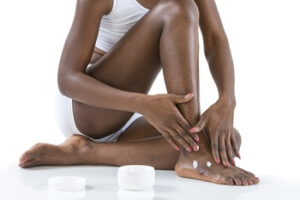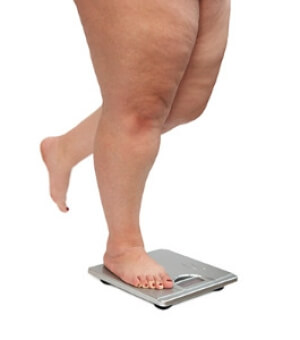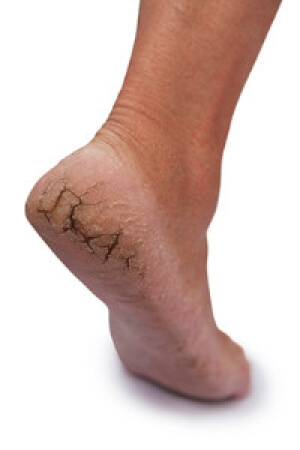Connect With Us
Super User
Achilles Tendon Injuries
The Achilles tendon is the largest tendon in the body; it is a tough band of fibrous tissue that stretches from the bones of the heel to the calf muscles. This tendon is what allows us to stand on our toes while running, walking, or jumping, it is common for this tendon to become injured. In severe cases, the Achilles tendon may become partially torn or completely ruptured. However, this tendon is susceptible to injury because of its limited blood supply and the high level of tension it endures.
The people who are more likely to suffer from Achilles tendon injuries are athletes who partake in activities that require them to speed up, slow down, or pivot. Consequently, athletes who engage in running, gymnastics, dance, football, baseball, basketball, or tennis are more likely to suffer from Achilles tendon injuries. Additionally, there are other factors that may make you more prone to this injury. People who wear high heels, have flat feet, tight leg muscles or tendons, or take medicines called glucocorticoids are more likely to have Achilles tendon injuries.
A common symptom of an Achilles tendon injury is pain above the heel that is felt when you stand on your toes. However, if the tendon is ruptured, the pain will be severe, and the area may become swollen and stiff. Other symptoms may be reduced strength in the lower ankle or leg area, and reduced range of motion in the ankle. When the Achilles tendon tears, there is usually a popping sound that occurs along with it. People who have acute tears or ruptures may find walking and standing to be difficult.
If you suspect you have injured your Achilles tendon, you should see your podiatrist to have a physical examination. Your podiatrist will likely conduct a series of tests to diagnose your injury including a “calf-squeeze” test. Calf squeeze tests are performed by first squeezing the calf muscle on the healthy leg. This will pull on the tendon and consequently cause the foot to move. Afterward, the same test will be performed on the injured leg. If the tendon is torn, the foot won’t move because the calf muscle won’t be connected to the foot.
How Pointing and Flexing The Ankles Can Benefit the Feet
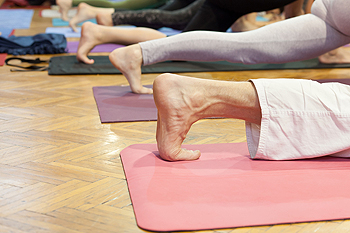 Research has shown the importance of performing proper foot stretches to maintain the overall health of the body. When the feet are strong, it may be easier to perform daily activities such as walking and running, in addition to possible prevention of foot conditions, such as plantar fasciitis or toe cramps. Pointing and flexing the ankles have been known to be beneficial. It will not only help the feet feel better, but may also help other issues in the body. If proper stretches are not routinely performed, foot conditions may develop, such as severe foot cramps and muscle spasms. If you would like additional information about the benefits of practicing foot stretches properly, please consult with a podiatrist.
Research has shown the importance of performing proper foot stretches to maintain the overall health of the body. When the feet are strong, it may be easier to perform daily activities such as walking and running, in addition to possible prevention of foot conditions, such as plantar fasciitis or toe cramps. Pointing and flexing the ankles have been known to be beneficial. It will not only help the feet feel better, but may also help other issues in the body. If proper stretches are not routinely performed, foot conditions may develop, such as severe foot cramps and muscle spasms. If you would like additional information about the benefits of practicing foot stretches properly, please consult with a podiatrist.
Stretching the feet is a great way to prevent injuries. If you have any concerns with your feet consult with one of our podiatrists from New Jersey Foot & Ankle Centers. Our doctors will assess your condition and provide you with quality foot and ankle treatment.
Stretching the Feet
Stretching the muscles in the foot is an important part in any physical activity. Feet that are tight can lead to less flexibility and make you more prone to injury. One of the most common forms of foot pain, plantar fasciitis, can be stretched out to help ease the pain. Stretching can not only ease pain from plantar fasciitis but also prevent it as well. However, it is important to see a podiatrist first if stretching is right for you. Podiatrists can also recommend other ways to stretch your feet. Once you know whether stretching is right for you, here are some excellent stretches you can do.
- Using a foam roller or any cylindrical object (a water bottle or soda can will do), roll the object under your foot back and forth. You should also exert pressure on the object. Be sure to do this to both feet for a minute. Do this exercise three times each.
- Similar to the previous one, take a ball, such as a tennis ball, and roll it under your foot while seated and exert pressure on it.
- Grab a resistance band or towel and take a seat. If you are using a towel, fold it length wise. Next put either one between the ball of your foot and heel and pull with both hands on each side towards you. Hold this for 15 seconds and then switch feet. Do this three times for each foot.
- Finally hold your big toe while crossing one leg over the other. Pull the toe towards you and hold for 15 seconds. Once again do this three times per foot.
It is best to go easy when first stretching your foot and work your way up. If your foot starts hurting, stop exercising and ice and rest the foot. It is advised to then see a podiatrist for help.
If you have any questions, please feel free to contact our office located in Oradell, NJ . We offer the newest diagnostic and treatment technologies for all your foot care needs.
Read more about How to Stretch Your FeetDifferent Types of Foot Pain
 There are several different types of foot pain that many people experience. Some patients may feel pain that radiates in the entire foot, which may be caused by a condition that is referred to as neuropathy. This may occur among diabetic patients as a result of elevated blood sugar levels, and may cause nerve damage. Additionally, if the pain is located in the ball of the foot, a condition known as Metatarsalgia may develop. This commonly occurs as a result of wearing shoes that do not fit correctly. Gout, hammertoe, or bunions may cause toe pain, and proper treatment may include adapting a lifestyle change or taking prescription medications. A common form of heel pain may be indicative of plantar fasciitis, which typically affects the tissue that links the heel and the toes together. It’s suggested that if you are experiencing any type of foot pain, a consultation with a podiatrist will be helpful in determining the best course of treatment.
There are several different types of foot pain that many people experience. Some patients may feel pain that radiates in the entire foot, which may be caused by a condition that is referred to as neuropathy. This may occur among diabetic patients as a result of elevated blood sugar levels, and may cause nerve damage. Additionally, if the pain is located in the ball of the foot, a condition known as Metatarsalgia may develop. This commonly occurs as a result of wearing shoes that do not fit correctly. Gout, hammertoe, or bunions may cause toe pain, and proper treatment may include adapting a lifestyle change or taking prescription medications. A common form of heel pain may be indicative of plantar fasciitis, which typically affects the tissue that links the heel and the toes together. It’s suggested that if you are experiencing any type of foot pain, a consultation with a podiatrist will be helpful in determining the best course of treatment.
Foot Pain
Foot pain can be extremely painful and debilitating. If you have a foot pain, consult with one of our podiatrists from New Jersey Foot & Ankle Centers. Our doctors will assess your condition and provide you with quality foot and ankle treatment.
Causes
Foot pain is a very broad condition that could be caused by one or more ailments. The most common include:
- Bunions
- Hammertoes
- Plantar Fasciitis
- Bone Spurs
- Corns
- Tarsal Tunnel Syndrome
- Ingrown Toenails
- Arthritis (such as Gout, Rheumatoid, and Osteoarthritis)
- Flat Feet
- Injury (from stress fractures, broken toe, foot, ankle, Achilles tendon ruptures, and sprains)
- And more
Diagnosis
To figure out the cause of foot pain, podiatrists utilize several different methods. This can range from simple visual inspections and sensation tests to X-rays and MRI scans. Prior medical history, family medical history, and any recent physical traumatic events will all be taken into consideration for a proper diagnosis.
Treatment
Treatment depends upon the cause of the foot pain. Whether it is resting, staying off the foot, or having surgery; podiatrists have a number of treatment options available for foot pain.
If you have any questions, please feel free to contact our office located in Oradell, NJ . We offer the newest diagnostic and treatment technologies for all your foot care needs.
Read more about Foot PainFoot Conditions That May Occur as a Result of Wearing Flip Flops
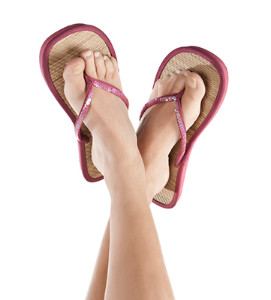 The type of footwear referred to as flip flops are popular summer shoes that are made of thin soles and typically are not meant to be worn for extended periods of time. Despite the fact that many people indulge in wearing these types of shoes, there may be moderate discomfort and symptoms that can be associated with them. These may include an achy feeling that may be present in the foot and ankle in addition to the formation of calluses and blisters. Other foot conditions that may develop as a result of wearing flip flops may be the development of bunions and hammertoes. The risk of injury may be increased from choosing to wear this type of shoe and this may occur as a result of a lack of stability. If you have questions pertaining to flip flops and would like additional information about the pros and cons for wearing this type of shoe, please schedule an appointment with a podiatrist who will be able to answer any questions you may have.
The type of footwear referred to as flip flops are popular summer shoes that are made of thin soles and typically are not meant to be worn for extended periods of time. Despite the fact that many people indulge in wearing these types of shoes, there may be moderate discomfort and symptoms that can be associated with them. These may include an achy feeling that may be present in the foot and ankle in addition to the formation of calluses and blisters. Other foot conditions that may develop as a result of wearing flip flops may be the development of bunions and hammertoes. The risk of injury may be increased from choosing to wear this type of shoe and this may occur as a result of a lack of stability. If you have questions pertaining to flip flops and would like additional information about the pros and cons for wearing this type of shoe, please schedule an appointment with a podiatrist who will be able to answer any questions you may have.
Flip-flops can cause a lot of problems for your feet. If you have any concerns about your feet or ankles, contact one of our podiatrists from New Jersey Foot & Ankle Centers. Our doctors will assist you with all of your foot and ankle needs.
Flip-Flops and Feet
Flip-flops have managed to become a summer essential for a lot of people. While the shoes may be stylish and easy to slip on and off, they can be dangerous to those who wear them too often. These shoes might protect you from fungal infections such as athlete’s foot, but they can also give you foot pain and sprained ankles if you trip while wearing them.
When Are They Okay to Wear?
Flip-flops should only be worn for very short periods of time. They can help protect your feet in places that are crawling with fungi, such as gym locker rooms. Athlete’s foot and plantar warts are two common fungi that flip-flops may help protect your feet against.
Why Are They Bad for My Feet?
These shoes do not offer any arch support, so they are not ideal for everyday use. They also do not provide shock absorption or heel cushioning which can be problematic for your feet. Additionally, you may suffer from glass cuts, puncture wounds, and stubbed toes since they offer little protection for your feet.
More Reasons Why They Are Bad for Your Feet
- They Slow You Down
- May Cause Blisters and Calluses
- Expose Your Feet to Bacteria
If you have any questions, please feel free to contact our office located in Oradell, NJ . We offer the newest diagnostic and treatment technologies for all your foot care needs.
Read more about Flip Flops and Your FeetFlip Flops and Your Feet
When the weather heats up, you may want to start wearing flip-flops. However, it has been proven that these are not the ideal shoes in terms of preserving the health of your feet.
Flip flops are known to expose your feet to different types of bacteria and fungal infections. When you wear your flip flops in public, you are exposing them to staphylococcus which is a skin-irritating bacterium. Athlete’s foot is also highly contagious and can be spread when you walk around nearly-barefoot.
Another harmful effect of wearing flip-flops is that they develop blisters on the feet. This is because the thin strap rubs against the skin with each step taken. Unfortunately, when blisters pop, they cause you to be more vulnerable to pathogens you pick up by having your feet exposed.
These shoes may also cause “shooting pains”. If you have flat feet, you need arch support to keep your knees, hips, and back in alignment. If you wear flat shoes, your joints are forced to compensate which can cause injuries throughout the body.
If you constantly wear flip-flops, you should avoid doing so as they can lead to many problems for your feet. If you are experiencing any of these foot issues, you should seek help from a podiatrist right away.
Causes of Cuboid Syndrome
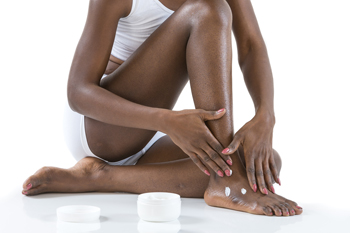 The cuboid bone is one of seven bones that is located on the outside of the foot. The main function of this bone is to function as the connecting link between the foot and the ankle. Additionally, it provides the necessary stability the body needs while walking and running. The condition referred to as cuboid syndrome occurs when the tendons and ligaments tear and this may typically happen as a result of an injury. There are several symptoms that may be associated with this ailment, including pain and discomfort on the outside of the foot next to the pinky toe, swelling in the ankle area, or redness near the injury and surrounding areas. The most common reasons for this condition to occur may be twisting the ankle during a fall, and repeated strain due to overuse, which often occurs during sporting activities. There may be several ways to treat cuboid syndrome, and it’s suggested to speak with a podiatrist as quickly as possible to learn what the best treatment technique is right for you.
The cuboid bone is one of seven bones that is located on the outside of the foot. The main function of this bone is to function as the connecting link between the foot and the ankle. Additionally, it provides the necessary stability the body needs while walking and running. The condition referred to as cuboid syndrome occurs when the tendons and ligaments tear and this may typically happen as a result of an injury. There are several symptoms that may be associated with this ailment, including pain and discomfort on the outside of the foot next to the pinky toe, swelling in the ankle area, or redness near the injury and surrounding areas. The most common reasons for this condition to occur may be twisting the ankle during a fall, and repeated strain due to overuse, which often occurs during sporting activities. There may be several ways to treat cuboid syndrome, and it’s suggested to speak with a podiatrist as quickly as possible to learn what the best treatment technique is right for you.
Cuboid syndrome, also known as cuboid subluxation, occurs when the joints and ligaments near the cuboid bone in the foot become torn. If you have cuboid syndrome, consult with one of our podiatrists from New Jersey Foot & Ankle Centers. Our doctors will assess your condition and provide you with quality foot and ankle treatment.
Cuboid syndrome is a common cause of lateral foot pain, which is pain on the outside of the foot. The condition may happen suddenly due to an ankle sprain, or it may develop slowly overtime from repetitive tension through the bone and surrounding structures.
Causes
The most common causes of cuboid syndrome include:
- Injury – The most common cause of this ailment is an ankle sprain.
- Repetitive Strain – Tension placed through the peroneus longus muscle from repetitive activities such as jumping and running may cause excessive traction on the bone causing it to sublux.
- Altered Foot Biomechanics – Most people suffering from cuboid subluxation have flat feet.
Symptoms
A common symptom of cuboid syndrome is pain along the outside of the foot which can be felt in the ankle and toes. This pain may create walking difficulties and may cause those with the condition to walk with a limp.
Diagnosis
Diagnosis of cuboid syndrome is often difficult, and it is often misdiagnosed. X-rays, MRIs and CT scans often fail to properly show the cuboid subluxation. Although there isn’t a specific test used to diagnose cuboid syndrome, your podiatrist will usually check if pain is felt while pressing firmly on the cuboid bone of your foot.
Treatment
Just as the range of causes varies widely, so do treatments. Some more common treatments are ice therapy, rest, exercise, taping, and orthotics.
If you have any questions, please feel free to contact our office located in Oradell, NJ . We offer the newest diagnostic and treatment technologies for all your foot care needs.
All About Cuboid Syndrome
Though cuboid syndrome predominately affects athletes, non-athletes can suffer from it too. Cuboid syndrome is also called cuboid subluxation or cuboid fault syndrome, and occurs when a joint or ligament near the cuboid bone of the foot becomes damaged, or when the bone itself is dislodged from its natural position. Pain may be persistent, or come and go, and it is usually marked by the outside of the foot. Cuboid syndrome, unless severe, can be difficult to diagnose. A doctor will likely ask questions about how long the pain has been present, and will apply pressure on the cuboid bone to determine the origin of pain.
There are a number of causes that can lead to the syndrome. Due to athletic activities, repeated stress placed on the foot can cause cuboid subluxation. Ballet dancers, runners, and other athletes often develop this condition. Basketball or tennis players may also develop this condition, as they place stress on their feet while moving side to side. Cuboid syndrome can often develop over time; however it can come out of a sudden injury as well. Over pronation, or other problems with feet, can exacerbate the condition if not corrected.
Among podiatrists, there is some disagreement about the treatment, as well as the definition of cuboid syndrome. Some see the injury as an injury to the ligaments located nearby the cuboid bone, while others believe it refers to the dislocation of the calcaneal-cuboid joint only. Treatment opinions differ as well. Although it can be treated by manipulation in order to reposition the bone, this must be done with extreme care in order to avoid injury. Some doctors, however, prefer treatment through the use of orthotic pads, designed to keep the bone in its place. Effectiveness of these treatments may vary, according to the severity of the injury.
When you experience side foot pain, it is important that you seek medical assistance. If a subluxed cuboid is caught and treated early, treatment is usually successful, and individuals may begin activities such as sports when the pain subsides. If left untreated, the pain will worsen, and the condition could cause permanent damage.
Different Types of Foot Surgery
 The feet and ankles undergo pressure as a result of consistent weight and gradually endure wear and tear as time progresses. Some patients develop arthritis, which can produce considerable pain and discomfort. This inflammation may affect the smaller bones in the foot, and may require surgery to obtain relief. If you are suffering from the pain of a bunion, surgery may be a viable option for permanent removal. This type of surgery is referred to as an osteotomy, and this involves straightening the big toe. If you have developed hammertoe, a procedure that is known as arthroplasty will repair the flexibility in the affected joints. If the plantar fascia should become inflamed, minor surgery may be performed that will separate this tissue from the heel bone. Please consider consulting with a podiatrist if you would like additional information about the many different types of foot surgery.
The feet and ankles undergo pressure as a result of consistent weight and gradually endure wear and tear as time progresses. Some patients develop arthritis, which can produce considerable pain and discomfort. This inflammation may affect the smaller bones in the foot, and may require surgery to obtain relief. If you are suffering from the pain of a bunion, surgery may be a viable option for permanent removal. This type of surgery is referred to as an osteotomy, and this involves straightening the big toe. If you have developed hammertoe, a procedure that is known as arthroplasty will repair the flexibility in the affected joints. If the plantar fascia should become inflamed, minor surgery may be performed that will separate this tissue from the heel bone. Please consider consulting with a podiatrist if you would like additional information about the many different types of foot surgery.
Foot surgery is sometimes necessary to treat a foot ailment. To learn more, contact one of our podiatrists of New Jersey Foot & Ankle Centers. Our doctors will assist you with all of your foot and ankle needs.
When Is Surgery Necessary?
Foot and ankle surgery is generally reserved for cases in which less invasive, conservative procedures have failed to alleviate the problem. Some of the cases in which surgery may be necessary include:
- Removing foot deformities like bunions and bone spurs
- Severe arthritis that has caused bone issues
- Cosmetic reconstruction
What Types of Surgery Are There?
The type of surgery you receive will depend on the nature of the problem you have. Some of the possible surgeries include:
- Bunionectomy for painful bunions
- Surgical fusion for realignment of bones
- Neuropathy decompression surgery to treat nerve damage
Benefits of Surgery
Although surgery is usually a last resort, it can provide more complete pain relief compared to non-surgical methods and may allow you to finally resume full activity.
Surgical techniques have also become increasingly sophisticated. Techniques like endoscopic surgery allow for smaller incisions and faster recovery times.
If you have any questions please feel free to contact our office located in Oradell, NJ . We offer the newest diagnostic and treatment technologies for all your foot and ankle needs.
Read more about Foot and Ankle SurgeryHow Increased Weight May Affect the Feet
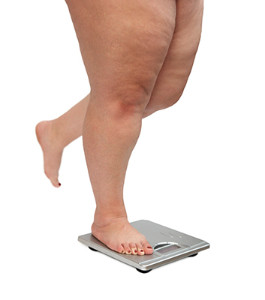 Recent research has shown that approximately 70 percent of the population in the Bahamas are obese. This typically impacts the general health of the feet as a result of the additional weight the feet must endure. An increased BMI, or body mass index, generally accompanies any weight that is gained. This may produce unwanted foot conditions that may include plantar fasciitis, tendonitis, arthritis and general “wear and tear” of the bones, ligaments, and tendons. Additionally, the structure of the foot may be negatively affected, which may aid in difficulty maintaining an exercise program. While purchasing shoes, it’s important to choose shoes that fit correctly, which may help to diminish a portion of the pain that may be experienced. If you feel you are obese and would like additional information about this condition on how it may affect the feet, please consult with a podiatrist.
Recent research has shown that approximately 70 percent of the population in the Bahamas are obese. This typically impacts the general health of the feet as a result of the additional weight the feet must endure. An increased BMI, or body mass index, generally accompanies any weight that is gained. This may produce unwanted foot conditions that may include plantar fasciitis, tendonitis, arthritis and general “wear and tear” of the bones, ligaments, and tendons. Additionally, the structure of the foot may be negatively affected, which may aid in difficulty maintaining an exercise program. While purchasing shoes, it’s important to choose shoes that fit correctly, which may help to diminish a portion of the pain that may be experienced. If you feel you are obese and would like additional information about this condition on how it may affect the feet, please consult with a podiatrist.
The more you weigh, the harder your feet must work to support your body. If you’re an obese individual and are concerned about your feet, contact one of our podiatrists from New Jersey Foot & Ankle Centers. Our doctors can provide the care you need to keep you pain-free and on your feet.
Obesity and Your Feet
People who are overweight are putting more pressure on their ankles, knees, and hips as well as their feet. This unfortunately can lead to variety of different issues.
Problems & Complications Stemming from Obesity
- When the body is overweight, it tries to compensate by changing the way that it moves. An obese person may lean forward and put extra weight on the wrong part of the foot. This puts unnecessary stress on the feet.
- Obese people are also more likely to develop type II diabetes which is a condition that causes a lot of foot problems. People with diabetes often don’t feel the cuts and sores that they may have on their feet, which can lead to more complicated and severe issues.
- Plantar fasciitis is another foot condition that can be caused by obesity. Plantar fasciitis is an inflammation of the tissue along the bottom of the foot, which causes pain and stiffness while walking and climbing stairs.
If you have any questions, please feel free to contact our office located in Oradell, NJ . We offer the newest diagnostic and treatment technologies for all your foot care needs.
What Is The Most Common Cause Of Cracked Heels?
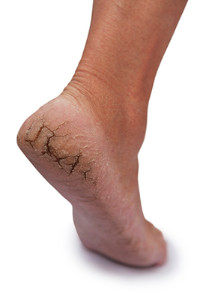 Some authorities have determined that cracked heels may develop as a result of the lack of attention the skin on the heels generally gets. There are many causes why this condition may occur, and having dry skin is generally the most common reason why this ailment may develop. Additionally, if the heels should endure excess pressure from being overweight, the chances of developing cracked heels may increase. There may also be a vitamin deficiency in the body, which may lead to the formation of heel fissures. If you stand for the majority of the day or frequently wear open-back sandals, the skin on the heels may gradually become dry and may lead to this uncomfortable condition. Partial relief may be obtained in washing and drying the feet thoroughly, followed by utilizing a good moisturizer. If you have this condition, please counsel with a podiatrist to learn about preventive measures and additional treatment options for cracked heels.
Some authorities have determined that cracked heels may develop as a result of the lack of attention the skin on the heels generally gets. There are many causes why this condition may occur, and having dry skin is generally the most common reason why this ailment may develop. Additionally, if the heels should endure excess pressure from being overweight, the chances of developing cracked heels may increase. There may also be a vitamin deficiency in the body, which may lead to the formation of heel fissures. If you stand for the majority of the day or frequently wear open-back sandals, the skin on the heels may gradually become dry and may lead to this uncomfortable condition. Partial relief may be obtained in washing and drying the feet thoroughly, followed by utilizing a good moisturizer. If you have this condition, please counsel with a podiatrist to learn about preventive measures and additional treatment options for cracked heels.
If the skin on your feet starts to crack, you may want to see a podiatrist to find treatment. If you have any concerns, contact one of our podiatrists from New Jersey Foot & Ankle Centers. Our doctors can provide the care you need to keep you pain-free and on your feet.
Cracked Heels
It is important to moisturize your cracked heels in order to prevent pain, bleeding, and infection. The reason cracked heels form is because the skin on the foot is too dry to support the immense pressure placed on them. When the foot expands, the dry skin on the foot begins to split.
Ways to Help Heal Them
- Invest in a good foot cream
- Try Using Petroleum Jelly
- Ease up on Soaps
- Drink Plenty of Water
Ways to Prevent Cracked Heels
- Moisturize After Showering
- Skip a Shower
- Keep Shower Water Lukewarm
- Don’t Scrub Your Feet
If you are unsure how to proceed in treating cracked heels, seek guidance from a podiatrist. Your doctor will help you with any questions or information you may need.
If you have any questions, please feel free to contact our office located in Oradell, NJ . We offer the newest diagnostic and treatment technologies for all your foot care needs.
